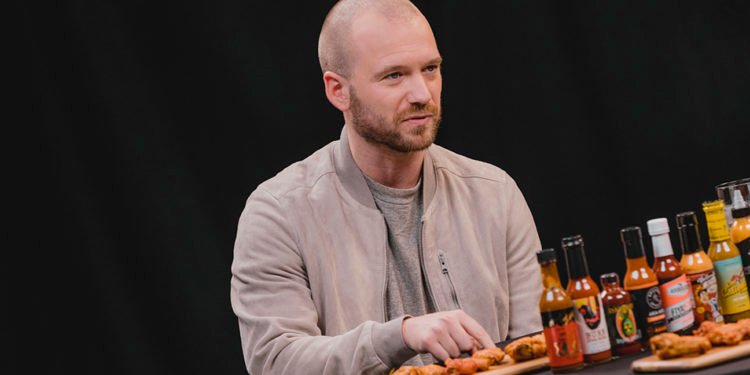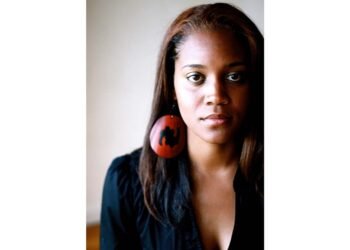Yet the gang’s smallness has amounted to huge things: In four years they have completed 10 seasons (Evans describes the schedule as “its own Rubik’s Cube”), featuring household names like Charlize Theron, James Franco, Bryan Cranston, Seth Rogen, Ricky Gervais, Aubrey Plaza, John Mayer, Natalie Portman, Gordon Ramsay, Scarlett Johansson, Ashton Kutcher and the Jonas Brothers.
First We Feast, the YouTube channel and brand responsible for producing Hot Ones (alongside Complex Networks), boasts 7.46 million subscribers, and the average episode earns anywhere from 1 to 10 million views. Oh, and the show also flaunts a collection of signature hot sauces, most notably The Last Dab, which, by tradition, is dabbed onto the last wing near the end of every interview. It is the signifier of survival: The guest completed the challenge, with or without any feeling left in their face.
The result of all this is that Evans has become a full-on celebrity in certain circles, which he feels most intensely every time he attends hot sauce expos. “I can’t move; it’s like LeBron James walking through,” he says, describing the mass fandom. When he’s not at a dizzying expo, Evans walks to work and only gets stopped “a couple of times” from people requesting pictures.
As Offerman collects the pile of shirts he brought as options to wear on camera (he bypassed the button-downs and opted for a simple gray polo) and goes off to get his parking ticket validated, Evans forgoes his usual post-Hot Ones ritual of taking a nap and sits down with THR to chat about his unusual job. He nurses a bottle of water — not what someone’s supposed to drink when recovering from a fiery mouth, but then this guy is the resident expert.
When you were a boy growing up in Crystal Lake, Illinois, were you the type who people would say, looking at your career now, “Oh yeah, we saw that coming.” Or were you the shy and reserved kind who came out of your shell while forging an onscreen career?
At that time I was obsessed with David Letterman and Howard Stern, so there was always this part of me that was interested in the “lights, camera, action” of it all and a part that thought I could do it. I went to the University of Illinois to be a broadcast journalism major — and wrote about Letterman and Stern to get in — so I feel like I was always interested in this.
Growing up, I could sit at any table in the cafeteria, and I think you see that a little bit in the show with this ability to be a chameleon and the way I relate to different entertainers, whether they’re a rapper, actor, singer or someone on YouTube. I was also chameleonlike in high school, so if you could ask kids then, [they might say], “Oh, it does make sense.” Plus I did have the showbiz dream and always loved TV and new shows.
How has your style been shaped by those journalists who were impactful for you?
What I always wanted to do — and it’s kind of our mantra around here — is to make something dumb for smart people. I want Hot Ones to give people that warm, fuzzy, TGIF Family Matters Christmas-episode feeling after they watch it. But the other side is that we want to be cerebral and take these bigger, broader intellectual ideas and put them in a meat casing that’s on everybody’s level.
There are a lot of different people who influenced my style. I always thought David’s irreverence was something that I liked; Stern’s ability to disarm the person he’s interviewing — you can go in prepared, but then you sit down with him and he takes you out of that flight pattern. We try to do the same thing with the scorching hot chicken wings: You can come in and have a plan, but when you get punched in the face by spice, all that goes through the window.
You’re known for eating spicy chicken and chatting with celebrities on YouTube, but real fans of Hot Ones will appreciate your research and preparation. What goes into planning for each guest?
As soon as we know [who the guest is], it’s like a fire drill. So we confirmed Offerman last week, locked in the studio space, got crew — in my head, I know I probably have 96 hours to figure out as much about him as possible.
With the research and putting together the run of show, it’s a team of three people: me; the creator of the show, Chris Schonberger; and my little brother, Gavin. We divide it up — I’ll take these podcasts, profiles, these YouTube interviews; you watch Parks and Recreation, figure out the certain Hot Ones tropes and connections that we can make organic and real in the interview. Then we’ll come back and say, “Here are the topics of conversation that are worth touching on.” We’ll cut those down to 10 topics, decide on a thesis question and a bunch of follow-ups. Those are compiled into a rough run of the show, and after that we’ll try to get the cliches out, figure out what can be punched up or added.
When we first started, [the formula was] as the wings get hotter the questions get hotter. But what we found in doing that is we were putting the most provocative, interesting question at a time when the person can’t even talk. So now we’ll hook people with a compelling interview in the first half, and then there’s a fireworks display of sauce reactions in the second half. Those two things are what makes Hot Ones.
With the rise of online and video journalism and the decline of print journalism, do you feel as if your role as a web producer/host/interviewer is both perfectly understood by one demographic and misunderstood by another?
I think that we’re living in a wild, wild West time in media. Hot Ones is really like a rose growing in the concrete of this mass pivot to video, laying off print journalists situation — it’s a chaotic upheaval.
But I will say the biggest compliment that I get paid is when we go to VidCon and I see parents with their kids, and they talk about how they watch this whole thing together. I remember when I was a little kid, I would sneakily watch Beavis and Butthead, and then when my dad came downstairs I changed the channel really quick. One time, he caught a punch line and laughed, and then sat down on the couch. All of a sudden, by virtue of this show being good, my dad gave me a pass to watch Beavis and Butthead. It became a thing we watched together. The same thing happened with South Park; it’s so irrefutably excellent and funny that it bridges the generational gap. There was this guy at VidCon, a salt-of-the-earth dad, and he was like, “Sean, let me tell you, he watches so much dumb shit on YouTube, but he showed me Hot Ones and it’s the best show. We watch it every Thursday, we get the wings” — that sort of thing makes me proud because I remember what it was like to discover cool and edgy shows that were a little bit above where I should be, and my dad being like, “This show is good enough for us to throw those rules out the door.”
There’s a lot of psychology that goes into your interviews, and part of your role is to read body language. Do you feel that this level of sensitivity had an effect on the way you interact with people in your personal life?
It’s weird, but I’m so empathetic; when I see people dying on hot sauce, I do feel for them. And I’m a Midwestern guy, so I think I’m just naturally nice and polite. When a high-profile celebrity sits down with you for an interview, there’s no obligation for them to give you anything. I know that — since we have scorching hot chicken wings, we’re already asking a lot of our guests, but if we can be thoughtful with our interview questions, they’ll stay committed because they can see how hard you’re working for them. A lot of times I’ll mass-watch interviews to see mistakes that other people make or what [encourages them] to perk up. I’ll also look at the things they get asked about in every single interview and how to veer away from that.
By way of the Hot Ones premise, famous people become more accessible as they sweat bullets on camera. What sort of feedback have you received from fans who had emotional reactions to watching their favorite celebs be pushed to their limit?
The only time I’ve caught heat is when Shawn Mendes fans came at me: “Are you hurting him?” [Mendes’ episode can be viewed here]. But more often than not, you see a more human side to these people. Celebrity is by definition an unobtainable lifestyle and status, but everyone can relate to dying on hot sauce, so what this is doing is taking someone you idolize and then bringing them down to your level. That works both ways — the celebrity can connect to their fans. Everybody always wants to make the show “What’s it like to have a beer with that person?” And everyone sucks at making it. We accidentally made it, and made it perfect.
RAPID-FIRE QUESTIONS
Favorite movie genre?
I’m a thriller/horror guy.
Last celeb death you were genuinely sad to hear about?
Anthony Bourdain was a tough one, especially considering what he did to pave the way for Matty Matheson, Eddie Huang and Action Bronson. And then all that those guys did to pave the way for people like me and all the others in the second wave of food internet personalities.
Last political speech that you found surprisingly impressive?
I liked Jon Stewart’s speech when he was standing up for the firefighters. I ran that back three or four times because it was so poignant, and then the way he speaks — it was moving and inspirational.
Hot sauce on Hot Ones that hurts the pit of your stomach every time?
Da Bomb. It’s almost bigger than the hot sauce lineup itself.
Memorable behind-the-scenes moment?
Back in the day in New York, we were shooting in an office on 50th Street, so outside of the studio there were tons of people working. High-profile celebrities would come barreling out of the door, “Where’s the bathroom?” Coolio was famously passed out in the greenroom while normal employees walked by. I always miss that office because the setting was so absurd.
QUICK DIVE INTO SEAN EVANS FAN ART
“I have no idea where this prayer candle came from. Some random person was selling Sean Evans bootleg merchandise, but because it’s so good, I don’t even care and put it up [on Instagram]. I hope they got rich off those candles. I see weird Sean stuff pop up all over the place, but this one was the first ‘Whoa, who the hell made this and why?’ laugh that I got from the internet.”
“This is probably my favorite piece of fan art,” says Evans. “It just captures the essence — they even have the dab on the chicken wing.”
Watch Nick Offerman’s episode below.
This interview was edited for length and clarity.















































